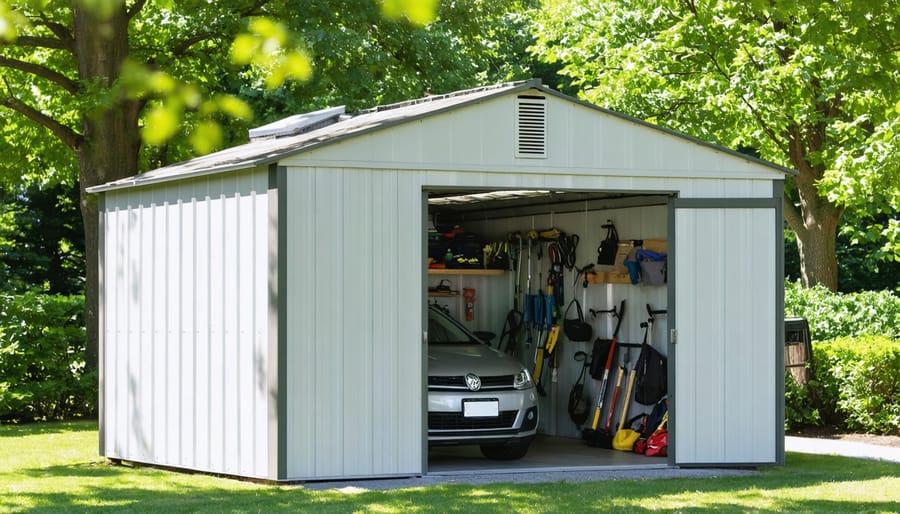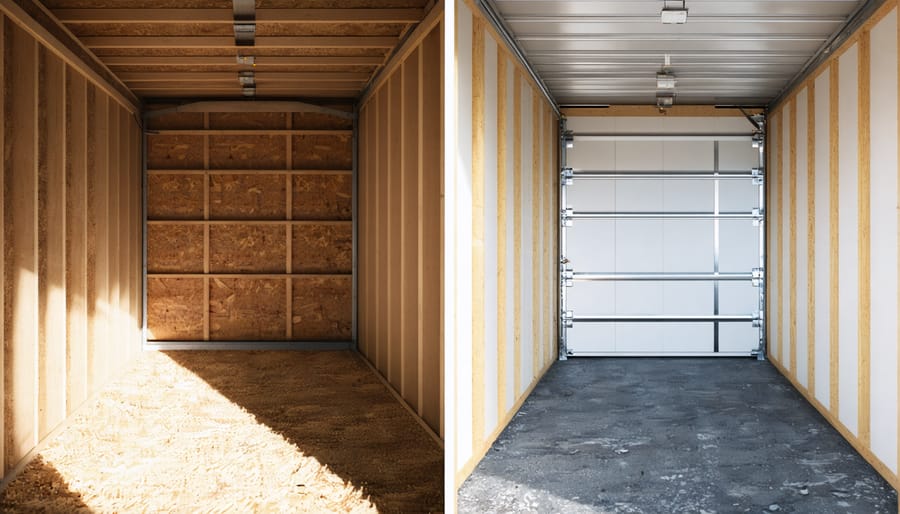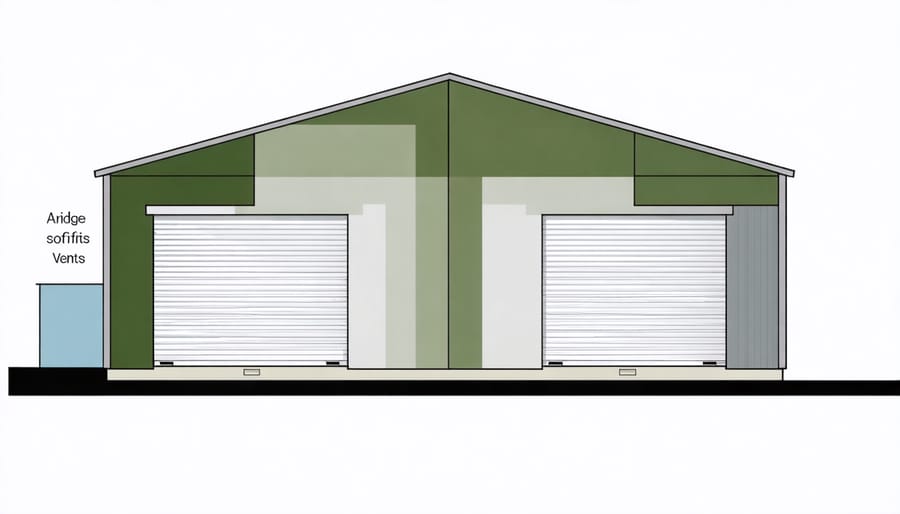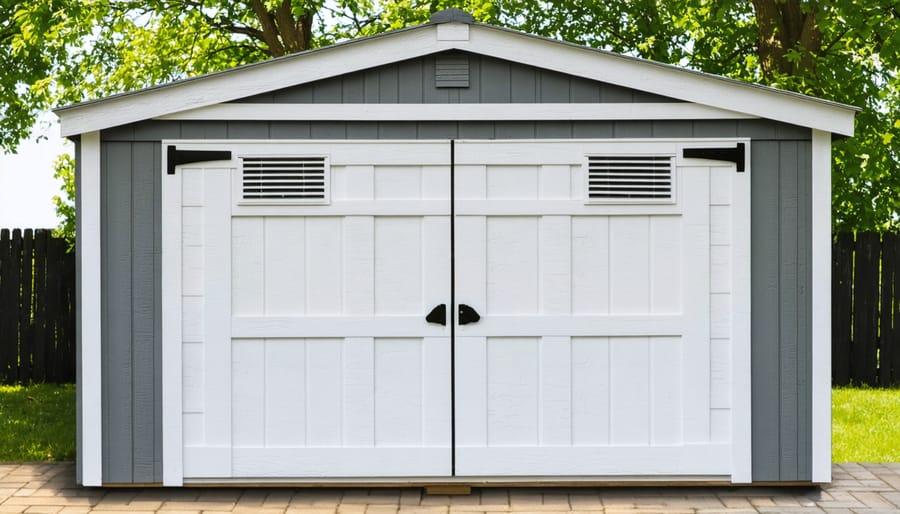Smart Shed Ventilation: Keep Your Storage Fresh and Your Belongings Protected

Proper storage shed ventilation stands as the critical defense between your valuable belongings and the damaging effects of moisture, mold, and extreme temperatures. Install roof vents at opposite ends of your shed to create essential cross-ventilation, preventing the buildup of stagnant air that can deteriorate tools, furniture, and seasonal items. Strategic placement of soffit vents along the eaves, combined with gable vents near the roof peak, creates a natural chimney effect that draws cool air in while expelling hot, humid air throughout the year.
Beyond protecting your investments, proper ventilation extends your shed’s structural lifespan by preventing wood rot, metal corrosion, and paint deterioration. Modern ventilation solutions range from passive systems like static vents to active options such as solar-powered fans, offering choices for every budget and climate condition. Whether you’re storing power tools, holiday decorations, or garden equipment, a well-ventilated shed provides the optimal environment for long-term storage while maintaining your shed’s integrity for years to come.
Why Your Storage Shed Needs Proper Ventilation
Moisture Control and Mold Prevention
Proper ventilation plays a crucial role in preventing moisture buildup, which is essential to keep tools from rusting and protect your valuable belongings. When humid air becomes trapped in your storage shed, it creates the perfect environment for mold growth and can lead to damaged items, warped wood, and musty odors.
Good airflow helps maintain a balanced environment by allowing damp air to escape while bringing in fresher, drier air. This natural circulation process is particularly important during seasonal changes when temperature fluctuations can cause condensation. By controlling moisture levels, you’ll protect everything from power tools and garden equipment to seasonal decorations and camping gear.
To maximize moisture control, consider using a combination of roof vents, wall vents, and floor gaps. This multi-level approach ensures comprehensive air movement throughout the shed, helping maintain optimal storage conditions year-round.

Temperature Regulation
Proper ventilation plays a crucial role in climate control for storage sheds, particularly when it comes to temperature regulation. During hot summer days, a well-ventilated shed can be up to 15 degrees cooler than one without adequate airflow. This temperature difference not only protects your stored items but also helps preserve the shed’s structural integrity.
Think of your shed as a miniature greenhouse – without proper ventilation, heat gets trapped inside, creating a cycle of rising temperatures. This can lead to warped wood, damaged tools, and compromised stored materials. In winter, good ventilation helps prevent condensation from forming when cold exterior temperatures meet warmer interior air, reducing the risk of mold and rust.
By maintaining consistent airflow, you create a more stable environment that protects your belongings year-round. This natural temperature regulation system works continuously, requiring no electricity while providing maximum protection for your stored items.
Essential Ventilation Features for Your Storage Shed
Ridge Vents and Soffit Systems
Ridge vents and soffit systems work together to create a powerful airflow that keeps your storage shed well-ventilated throughout the year. The ridge vent, installed along the peak of your shed’s roof, allows warm air to escape naturally as it rises. Meanwhile, soffit vents, placed under the roof’s overhang, draw in cooler air from outside to replace the expelled warm air.
This natural ventilation system is particularly effective because it creates a continuous flow of air without requiring any power or moving parts. When properly installed, ridge and soffit vents can help maintain optimal temperature levels and reduce moisture buildup in your shed.
For best results, aim for a balanced system with equal amounts of soffit and ridge vent space. A good rule of thumb is to provide 1 square foot of ventilation area for every 150 square feet of attic space, split evenly between ridge and soffit vents. Many modern storage sheds come with pre-installed ridge and soffit vents, but they can also be added to existing structures with the right tools and know-how.
Remember to keep both vents clear of debris and check them regularly during your seasonal maintenance routine to ensure they’re working effectively.

Wall Vents and Louvers
Wall vents and louvers are essential components for creating proper airflow in your storage shed. These side-mounted ventilation options come in various styles, from simple screened openings to adjustable louvers that let you control airflow. For maximum effectiveness, install vents on opposite walls to create cross-ventilation, which helps move stale air out while drawing fresh air in.
Most hardware stores offer affordable plastic or metal vents that are easy to install. A typical 8×10 shed benefits from two to four wall vents, depending on your climate and storage needs. When installing, position vents about 12 inches below the roof line to capture rising warm air, and consider adding lower vents near the floor for better circulation.
For added protection, choose vents with built-in pest screens and weather guards. These features prevent unwanted visitors while maintaining good airflow, even during rainy weather. Remember to keep the area around your vents clear of stored items to maintain optimal air movement throughout your shed.
Powered Ventilation Solutions
Electric fans and powered vents offer an active approach to keeping your shed well-ventilated. A simple plug-in fan can make a world of difference, especially in larger sheds where natural airflow might not be sufficient. Many shed owners find success with solar-powered fans, which are both eco-friendly and cost-effective since they don’t require electrical wiring.
Gable-mounted powered vents are particularly effective, automatically kicking in when temperatures rise above a certain threshold. These smart solutions work tirelessly to expel hot air while drawing in cooler air from below, maintaining optimal conditions for your stored items.
For those seeking a more sophisticated option, thermostat-controlled ventilation systems can be installed to regulate airflow automatically. While these powered solutions require a bigger initial investment, they provide peace of mind knowing your shed’s environment is being actively managed, especially during extreme weather conditions.
Just remember to position your powered ventilation devices strategically – typically high on walls or in the gables – to maximize their effectiveness.
Optimizing Your Shed’s Ventilation Setup
Ventilation Placement Strategies
Strategic placement of vents is crucial for creating effective airflow in your storage shed. For optimal ventilation, install vents near the roof peak or in gable ends to allow warm air to escape naturally. Place corresponding lower vents along the base of your shed walls to create a chimney effect, drawing fresh air in from below while pushing stale air out through the top.
A good rule of thumb is to position vents on opposite walls rather than the same side, which promotes cross-ventilation. For most standard-sized sheds, aim to install at least two pairs of vents – one pair high and one pair low. If your shed is larger than 120 square feet, consider adding additional vent pairs for every 60 square feet of floor space.
Remember to account for your local climate when deciding vent placement. In areas with prevailing winds, position lower vents on the windward side and upper vents on the leeward side to maximize natural airflow. Avoid placing vents where they might be blocked by stored items or outdoor obstacles, and ensure they’re protected from direct rain exposure with proper covers or hood designs.
Seasonal Ventilation Adjustments
Proper ventilation needs change with the seasons, and making simple adjustments can keep your shed and its contents in optimal condition year-round. During summer months, maximize airflow by keeping vents fully open and using fans when needed to prevent heat buildup and moisture accumulation. Consider adding a solar-powered fan for extra circulation on particularly hot days.
As winter approaches, reduce (but don’t completely close) ventilation to maintain some airflow while preventing excessive cold. Installing adjustable vents lets you fine-tune the airflow based on weather conditions. In spring and fall, pay special attention to humidity levels, as these transitional seasons often bring varied weather patterns. Keep vents partially open during rainy periods to prevent dampness from settling, but be ready to adjust them when dry, windy conditions occur.
Monitor your stored items regularly and adjust ventilation accordingly – if you notice any musty smells or condensation, increase airflow immediately.
Maintenance Tips
Regular maintenance of your shed’s ventilation system is crucial for its long-term effectiveness. Every season, inspect your vents for debris, cobwebs, and pest nests that could block airflow. Clean the vents using a soft brush or vacuum, and check that all mechanical parts of powered vents are moving freely. During spring and fall, remove leaves and other organic matter that might accumulate around external vent openings.
For turbine vents, apply a drop of lightweight oil to moving parts annually to ensure smooth operation. Check weather stripping around vents and replace if worn or damaged. If you have electric vents, test them monthly and clean the fan blades every six months to prevent dust buildup.
Keep vegetation trimmed away from external vents, maintaining at least a foot of clearance. During winter, inspect vents for ice formation, which can restrict airflow. Consider installing vent covers during severe weather but remember to remove them afterward to maintain proper ventilation.

DIY Ventilation Improvements
Improving your shed’s ventilation doesn’t have to be complicated or expensive. With a few basic tools and materials from your local hardware store, you can enhance airflow significantly. Start by installing static vents near the roof peak – simply cut circular holes using a hole saw and secure the vents with screws and weatherproof sealant. For added ventilation, consider adding soffit vents under the eaves.
A simple DIY turbine vent can be installed by cutting a hole in the roof and following the manufacturer’s mounting instructions. These spinning vents create excellent air circulation without electricity. For wall ventilation, louvered vents are straightforward to install – mark your cutting lines, drill starter holes, and use a jigsaw to create the opening.
If you’re comfortable with basic wiring, a solar-powered vent fan offers an eco-friendly solution. Mount a small solar panel on the roof and connect it to a ventilation fan – the fan will run whenever the sun shines, keeping your shed cool during peak heat.
For a cost-effective option, create adjustable ventilation by installing hinged panels near the roof. These can be opened and closed as needed using a simple rope-and-pulley system. Remember to seal all edges with weather stripping and caulk to prevent water infiltration while maintaining proper airflow.
Proper ventilation is essential for maintaining a healthy, functional storage shed that protects your valuable belongings. By implementing the right combination of passive and active ventilation methods, you can effectively control moisture, regulate temperature, and prevent damage to stored items. Remember to regularly inspect your ventilation system, clean vents and fans, and make adjustments based on seasonal changes. Whether you choose simple soffit vents or opt for a more comprehensive solution with powered ventilation, the key is to maintain consistent airflow throughout your shed. Don’t wait for moisture problems to develop – take action now to install or improve your shed’s ventilation system. Your stored items will thank you with years of protection from damage, and you’ll enjoy a cleaner, fresher storage space that serves you well through every season.

